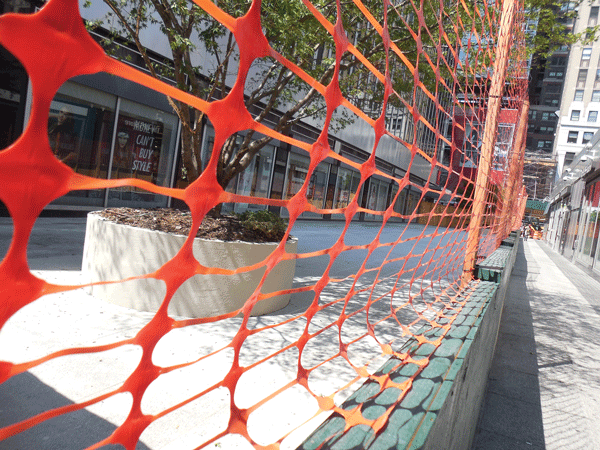BY RAANAN GEBERER | Like much of Manhattan, Chelsea has a scarcity of green spaces dedicated to nothing more than the simple acts of rest or play. Clement Clarke Moore Park, the Penn South playground, Chelsea Park, Hudson River Park, and Chelsea Waterside Park comprise a handful of options.
As part of their Affordable Housing plan, Community Board 4 (CB4) has begun to seriously consider the longstanding efforts of Friends of 20th Street Park (20thstreetpark.org) to convert a former Department of Sanitation lot (between Sixth and Seventh Aves.) into a micro-park. Any additional public space, no matter how small, would be welcome. Of Manhattan’s 12 Community Board areas, CB4 ranks dead last for parks within a quarter-mile of residents — and in the bottom quartile when compared against all 59 boards throughout NYC.
Little-Known Green Places and Resting Spaces
However, there are other, much smaller open spaces that are not official parks. Many of them are spaces between two buildings, with some plantings and benches. People who live and work nearby know about them, but most are not widely publicized.
Arnold Bob, a retired computer programmer who lives in Penn South, calls them “The Secret Parks of Chelsea.” In 2012, he created a map detailing these spaces (visit parkchelseanews.blogspot.com to view the map and access more information on Bob’s campaign for more public spaces in Chelsea).
“In 2009,” Bob explains, “my mother had open-heart surgery. Six months later she came to visit me. I left her outside so she could call up an Access-A-Ride. Then I got a call from her saying that she had stood waiting for an hour and the Access-A-Ride people never showed up. I looked into finding places where people can sit down in Chelsea, and did a map of places where people can sit down.”
Some of these spaces are Privately Owned Public Spaces (POPS), provided by private developers in exchange for additional floor area. POPS, according to the Department of City Planning, were provided for in a 1961 zoning resolution “to provide light, air, breathing room and green space to ease the predominately hard-scaped character of the city’s densest areas.” The best-known POPS in the city is Zuccotti Park. “The fact that it is a POPS is a quirk that allowed Occupy Wall Street to be there,” says James Yolles, spokesman for New Yorkers for Parks (visit ny4p.org for more info on the organization).
Many of the early POPS were deliberately designed to be only minimally inviting to the public, with little or no signage telling people they were accessible. “Some of the experts,” notes Yolles, “have called these spaces ‘privatization by design.’ ”
Revisions passed by the City Council in 2007 and 2009 mandated that POPS be easily seen from the street, be well-lit, have comfortable seating areas, and meet a set of established standards for things such as plantings and signage.
Apops.mas.org, a website maintained by Advocates for Privately Owned Public Space and the Municipal Art Society, details these spaces throughout the city.
CB4 District Manager Robert Benfatto says, “The community doesn’t have a lot of open green space. Anything we can get is welcome.” There are few problems, he says — and if there are any, the board reaches out to the spaces’ owners.
Bob would like signs pointing to these “secret parks” three blocks away, placed on sidewalks. He also would like to see signs telling area residents what they can do in these spaces, to accompany the existing required signage that spells out what they can’t do (usually bike riding, loud radio-playing, skateboarding, etc.).
Here are some local “secret parks,” both POPS and others:
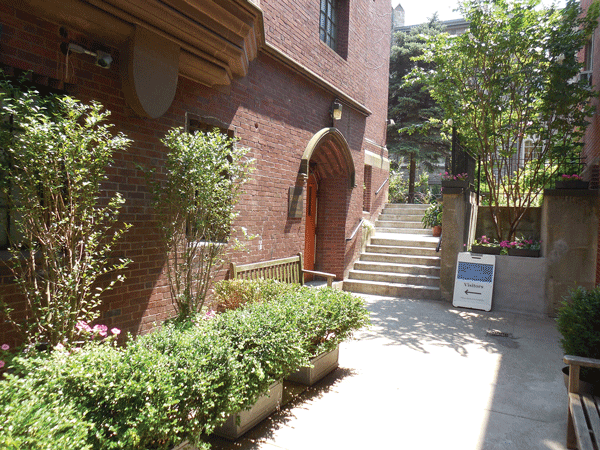
The entrance to the inner courtyard/garden of the General Theological Seminary.
THE GENERAL THEOLOGICAL SEMINARY COURTYARD
The spacious interior courtyard and garden (at 440 W. 21st St., btw. Ninth & 10th Aves.) is not a POPS, but has long been open to the public. Visitors are requested to sign their name and present ID. Chad Rancourt, director of communications for the seminary, explains that the institution is also a “residential community” for seminary students and needs to protect students’ privacy (hence the no-picture-taking policy). Rancourt adds that earlier this year, the seminar held a community gathering in the garden for 100 people. Visit gts.edu for more info.
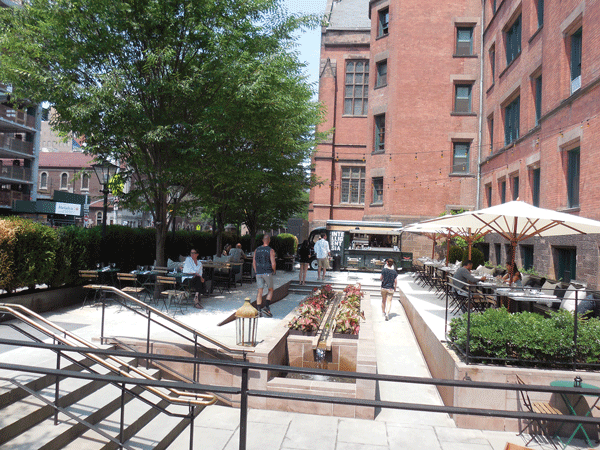
The front garden of the High Line Hotel is free, and open to the public (food truck charges apply).
THE HIGH LINE HOTEL’S FRONT GARDEN
Located at 180 10th Ave. (btw. 20th & 21st Sts.), there is a seating area with tables where many people congregate, a coffee and tea truck, and a small sign saying “Please enjoy our garden.” According to CB4, the hotel agreed to put up the sign to show it is “making an effort towards becoming a good neighbor,” after it had applied for a loading zone in front.
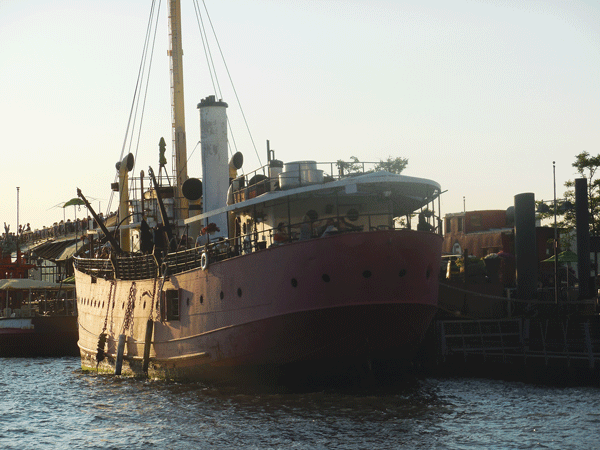
The Frying Pan, a decommissioned lightship off Pier 66, continues John Krevey’s legacy of public access to the waterfront.
THE FRYING PAN
This decommissioned lightship off Pier 66 is not, strictly speaking, a park — but it’s one of the area’s most unique destinations for scenic vistas and serenity. Angela Krevey, whose husband, John Krevey, founded the institution, says, “My husband, John Krevey, was a big public access proponent. It was his vision to get people down to the waterfront.” The Frying Pan is open Friday through Sunday for self-guided tours — and while much of the adjacent barge is occupied by a restaurant, “people can just come down and watch the sunset,” she says. Visit fryingpan.com
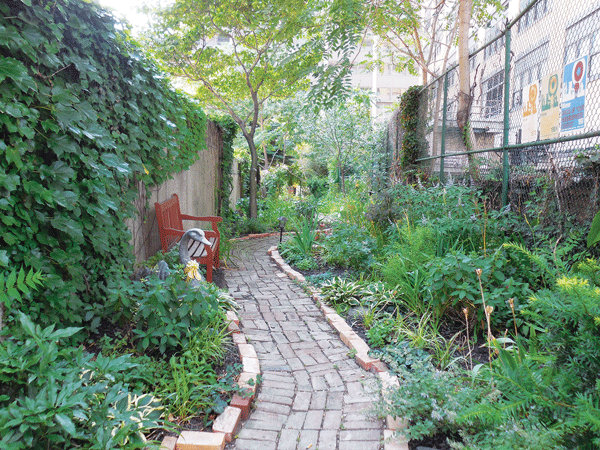
Alice’s Garden, on W. 34th St., is jointly managed by managed by the Hell’s Kitchen Neighborhood Association and the Clinton Housing Development Corp.
ALICE’S GARDEN
A “Key Park” located on 34th St. (btw. Dyer & 10th Aves.), the garden was established by neighborhood resident Alice Parsekian, who died in 2010. Since then, it has been managed by the Hell’s Kitchen Neighborhood Association and the Clinton Housing Development Corp., which lease the land from the Port Authority for $1 a year. Members of the public can obtain a key, for $2, by visiting CB4’s 330 W. 42nd St. office (call 212-736-4536 for more info). That key also allows you to access Teresa’s Park (39th St., west of Ninth Ave.), Bob’s Park (35th St., btw. Dyer & 10th Aves.), and Juan Alonso Park & Community Garden (51st St. & 11 Ave.).
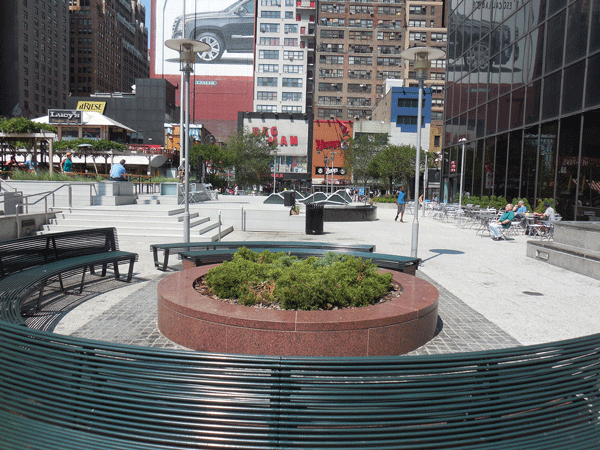
ONE PENN PLAZA PARK
This model POPS (located from 33rd to 34th Sts., right off of Eighth Ave.) has large circular benches, plantings, and conventional tables and seats. On a recent visit, a crowd of office workers was gathered there, cheering on the USA in a World Cup soccer match on a nearby screen at Lucy’s Cantina Royale.
ONE PENN PLAZA PARK EAST
This somewhat narrower park also spans the length of 33rd to 34th Sts., but is closer to Seventh Ave. Most of the park is currently fenced off, to accommodate renovation work.
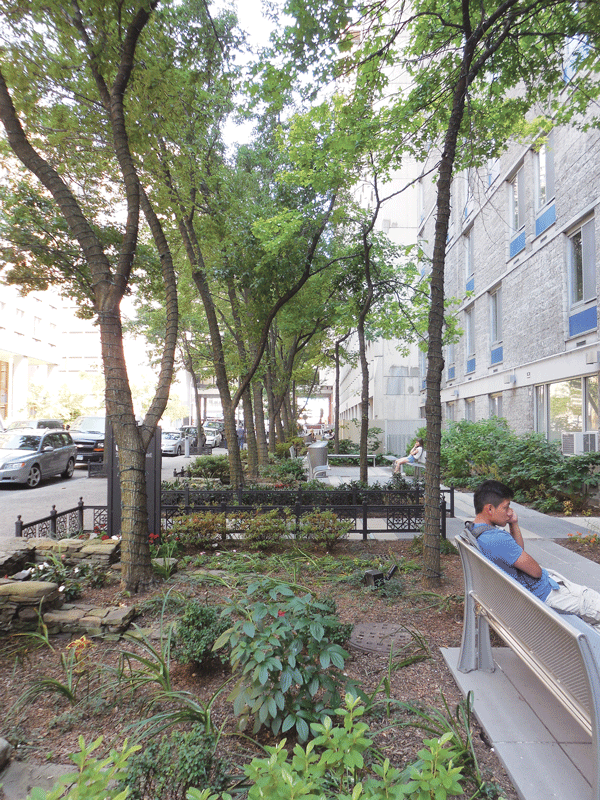
Comfortable seats, soothing greenery and shade can be found in front of various Fashion Institute of Technology halls (W. 27 St., btw. Seventh & Eighth Aves.).
THE FASHION INSTITUTE OF TECHNOLOGY PLAZA
Taking up the entire span of W. 27th St., btw. Seventh & Eighth Aves., this inviting plaza has tall trees, planters, and benches. Cheri Fein, spokeswoman for FIT, says, “We are a public institution. We did landscaping with nice benches, primarily for the students and staff but also as a place where the public can come to.” School security officers patrol the area.
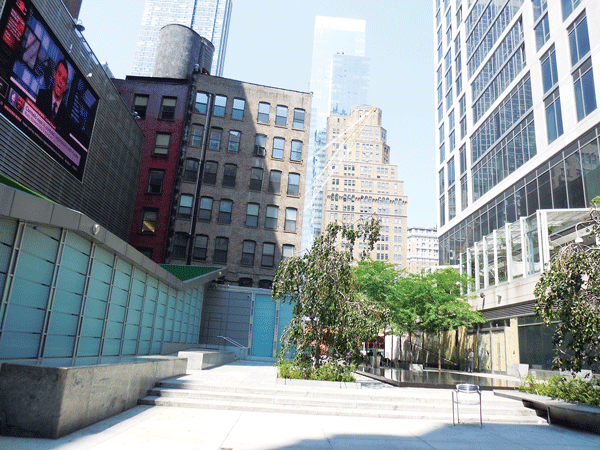
Big Screen Plaza has benches, plantings, a reflecting pool and, of course, the big screen.
BIG SCREEN PLAZA
Located between 29th and 30th Sts. (off the west side of Sixth Ave.) is another “by the book” POPS — it has an official sign with the tree logo, seating areas, a reflecting pool, and, of course, a big screen. Dave Scala, digital director of the plaza, says the site hosts viewing for the Oscars, Emmys, World Cup and more. Most of the events are hosted inside the nearby Eventi Hotel’s restaurant, says Scala, but “people are free to watch the screen from the plaza.” However, he says, “We don’t amplify sound out there.” Visit bigscreenplaza.com for more info.
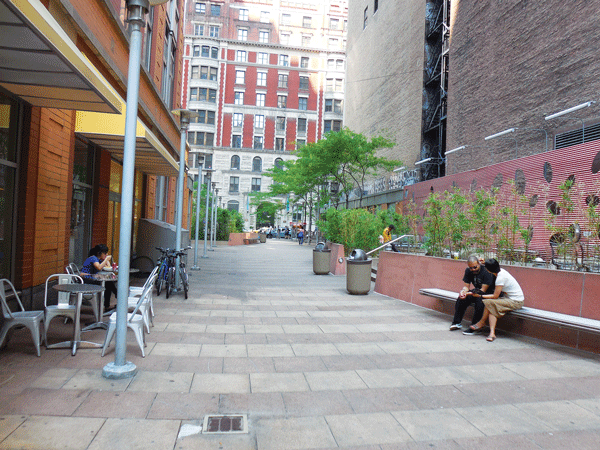
Innovative wall design, plantings and seating, in a breezy area adjacent to The Capital at Chelsea (26th St., just off of Sixth Ave.).
774 SIXTH AVENUE
Actually located on the north side of 26th St., this is a good example of a POPS site whose owners, The Capitol at Chelsea (a luxury building), have done everything “by the book.” A sign with the Department of City Planning’s requisite POPS tree logo spells out the site’s amenities, its hours of operation, the fact that it’s disabled-accessible, and even a number to call for complaints. There are several seating areas, a futuristic wall design and attractive plantings.



